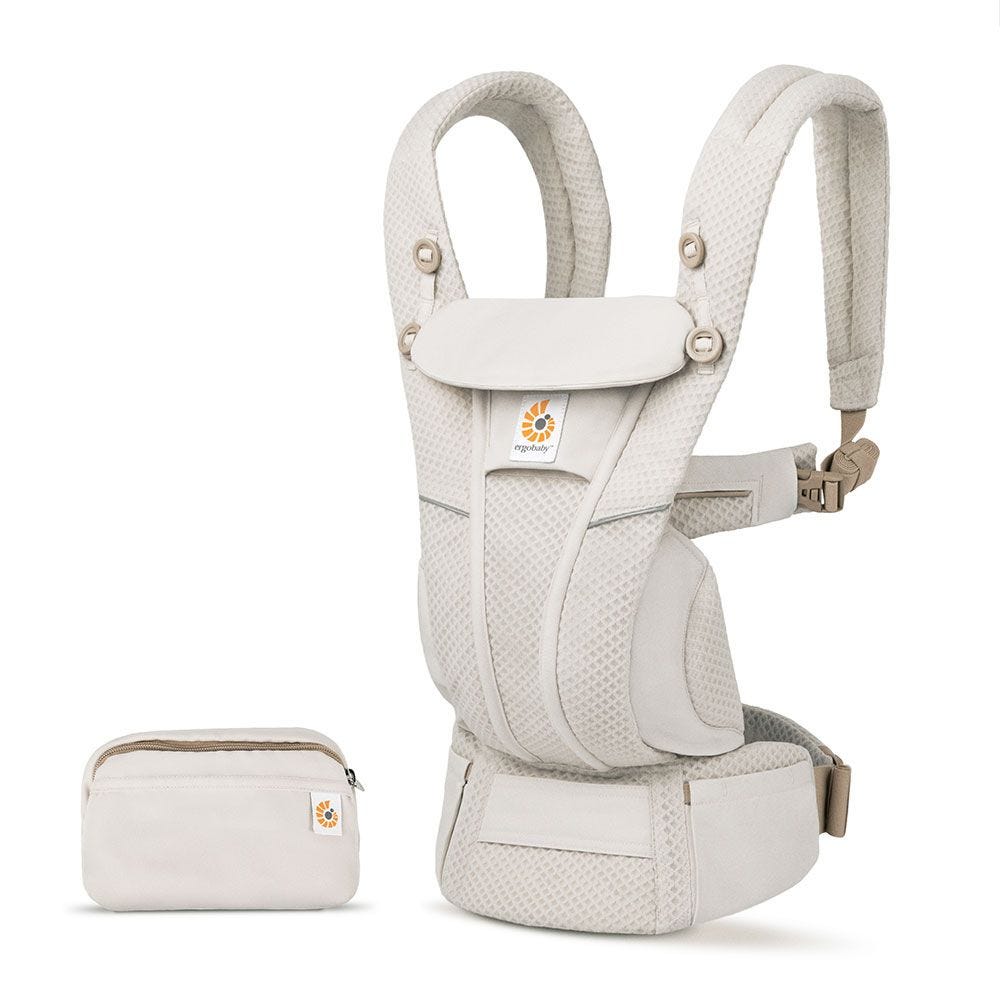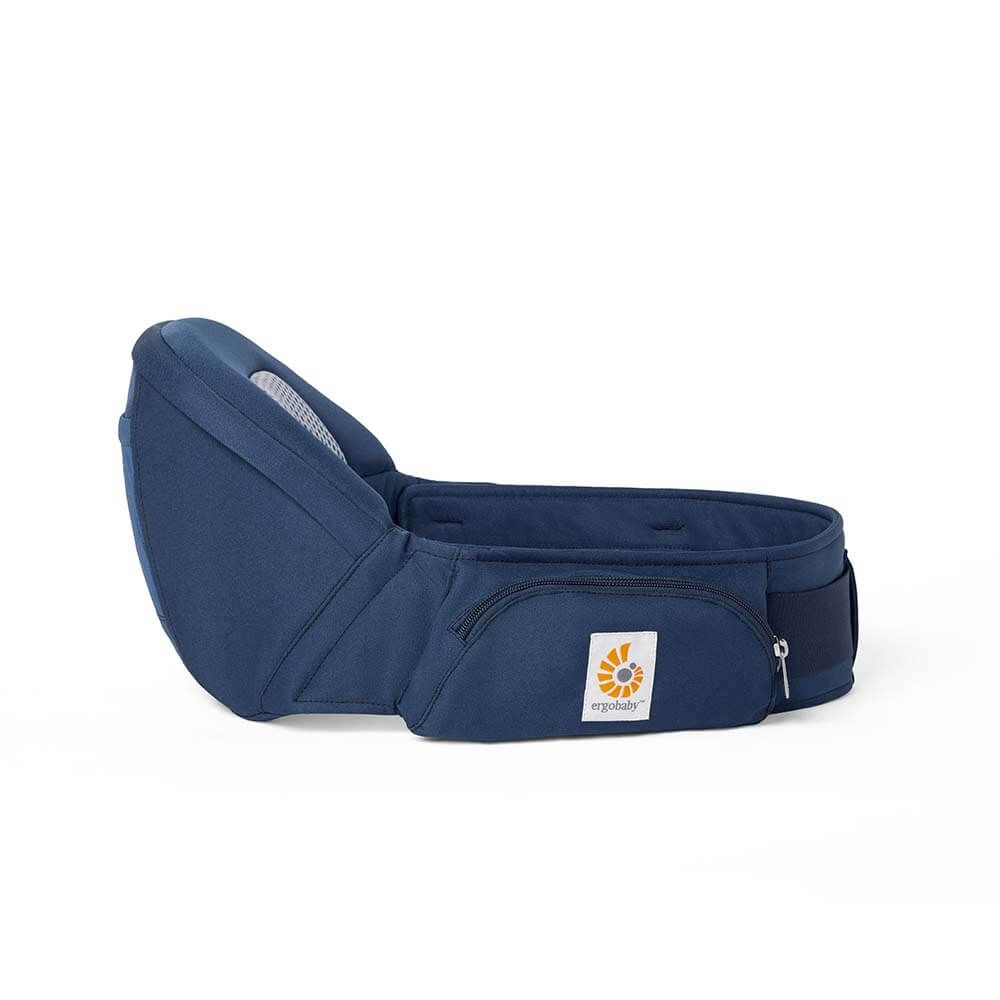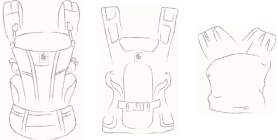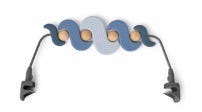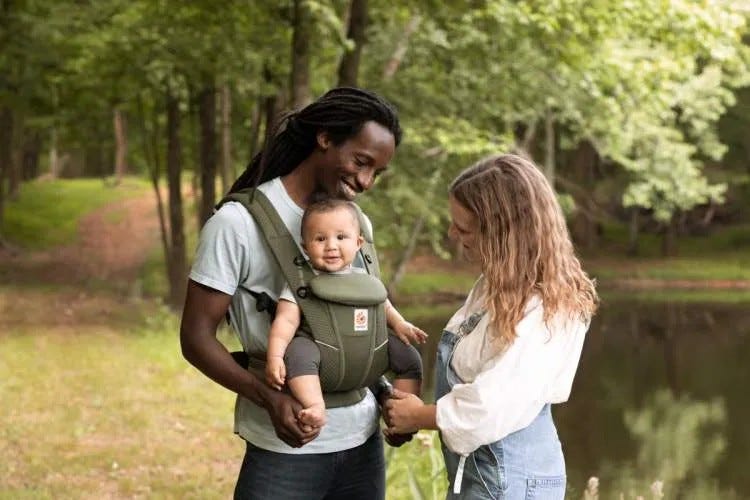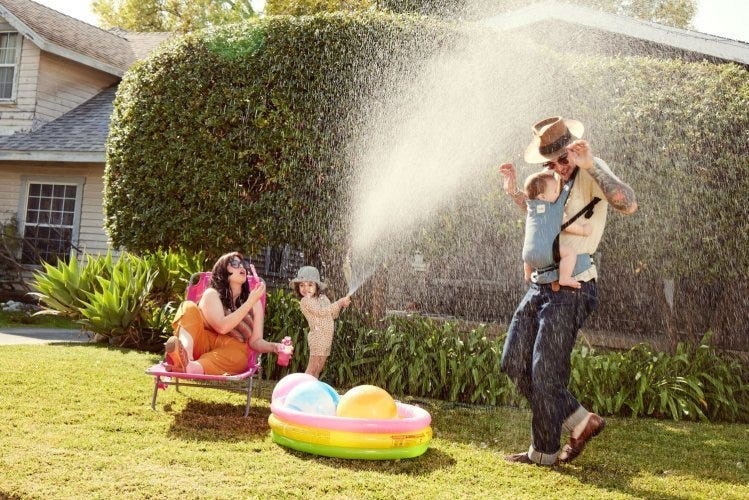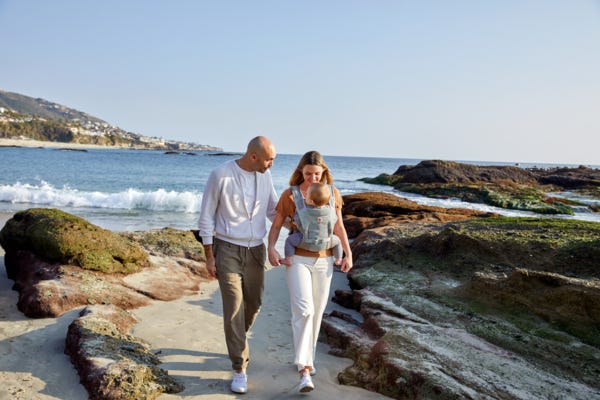
Should my baby face in or out in a carrier?
Many baby carriers offer a variety of carry positions, but not all carry positions are safe to use throughout baby's development. This blog will share some of the developmental milestones to look for so you can safely carry your baby though the world.
Let's begin with validating the basic idea that it is good for a baby to be stimulated by parents and other caregivers. One of the key results of the great amount of research done on the baby's developing brain is indeed how vital appropriate stimulation is.
When the baby is born, the number of neurons in its brain corresponds to adults'. However, what is missing is the mind-boggling amount of connections that will eventually shape that particular baby's personality and intelligence. These connections are formed by and are utterly dependent on the type of stimuli that the baby receives from the outside world.
Every experience the baby is exposed to will activate some part of the brain's neurons. The more frequently a given experience occurs, the stronger the connections between the activated neurons become. As neuroscientists sometimes say: "Cells that fire together, wire together."
All About Baby Carriers for Nature Adventures
However, just as there is no point in trying to teach a newborn how to ice skate, certain types of stimulation are more appropriate at specific developmental phases than others. To understand what types of stimulation are appropriate and beneficial, we need to look at the major developmental phases that a baby goes through in her first year.
Three Stages of Baby's Development
In the first few months after birth, the baby's main developmental task is adaption to life outside the womb. A variety of basic functions have to be mastered: suckling, digesting, breathing, vocalizing, defecating, and seeing. These are initially demanding tasks and the baby therefore spends much of her time in what is called "adjustment states”: sleeping, drowsing, fussing, and crying.
Occasionally, it is as if the baby surfaces and moves into the quiet alert phase, which is just that. The baby is quiet and looks around attentively and takes in the world. Or rather, the very immediate world, as the baby's zone of vision is limited in the first few months to 8 to 10 inches. Incidentally this is also the approximate distance between your face and your baby's face when holding your baby in your arms or breastfeeding.
1.) Age 2-3 Months At around 2-3 months of age, the baby begins to actively seek out social exchanges with adults, using their glance and smile to attract attention and initiate conversations or playful episodes. Mothers and fathers naturally respond to these cues with exaggerated facial expressions and higher-pitched voices, looking to attract attention and engage their child.
2.) Age 2-6 Months This marks the beginning of a phase, lasting about three or four months (age 2-6 months) where the baby is intensely interested in the human face. The baby's game is all about learning the rules of human social interaction, reading and interpreting the great multitude of facial expressions that the mother, father and other caregivers will exhibit. In their quest to engage and bring joy to their baby, taking turns in communicating, the baby will also learn how to tolerate and regulate the excitement and sometimes frustration that builds up in each playful episode. These innocent-looking play episodes are neurologically vital in creating empathy, social and communication skills, a capacity for joy and the ability to tolerate stress.
3.) Age 6 Months+ From around 6 months of age, with the emergence of eye-hand coordination, the baby's attention gradually switches towards the world of objects. The baby also becomes able to move about by initially crawling and sets out to explore the surroundings with its newly won capacity for movement. The primary caregivers are no longer the baby's center of attention as was the case in the preceding months. Their primary role becomes to help the baby decipher and interpret ambiguous situations where the baby feels insecure. An illustrative laboratory test of this is when a baby has to cross a glass (transparent) covered hollow to reach a desirable object.
The baby will check the mother's facial expression; if her face expresses horror or uncertainty, the baby will not cross the hollow. If, on the other hand, the mother via her facial expressions encourages the baby to continue, she will do just so. The baby uses the caregiver to regulate her own emotions and behavior. This is the phase where the baby learns to share attention with another person, following the direction of the caregiver's glance and also enlisting the help of the caregiver to obtain objects outside of its reach, by pointing and checking if the caregiver is putting the attention on the desired object. The baby will also become emotionally attached to the primary caregivers and begin to show signs of distress at separation and towards friendly advances from strangers, using the caregivers as "a safe base."
How These Developmental Phases Relate to the Ideal Carrying Positions When Using a Baby Carrier
Front Inward Facing Position
For the first several months, the baby is more than content with being carried in the front position, facing inward towards the caregiver. From a developmental point of view, the baby's primary tasks are related initially to adaptation to life outside the womb where it certainly does not need excessive stimulation. Quite the contrary, at the "social awakening" period at around 2-3 months, the baby's main interest will be the human face, and here the front inward facing position will continue to be ideal for most babies as they will have a clear view of the caregiver's hopefully exciting and stimulating face. The baby can also observe the caregiver's face when she/he is communicating with others, providing the baby with learning experiences.


Advantages of Using Strollers for Nature Adventures
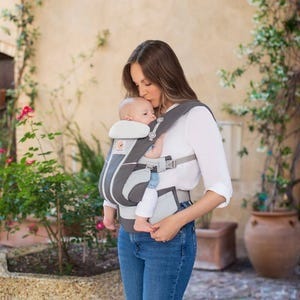

Sometime during the baby’s first year, most babies placed in the front inward facing position will begin to turn their head to get a better view of the action taking place behind them. Given the flexibility of a baby’s neck and the wide zone of vision that eye movement allows for, the baby will in fact be able to take in quite a lot of the surrounding environment. Especially if the adult carrying the baby is a little vigilant to the baby’s signals, and aid the baby’s efforts to take in the world by turning appropriately to the side. If this solution works for you, and your baby is content, we strongly suggest that you keep your baby in the front inward facing position. All of Ergobaby's carriers offer the front inward carry position. If you are taking an Ages and Stages journey, you'll begin with the Embrace Newborn Carrier or Aura Wrap and as your little one starts reaching new milestones, you will level up to the Omni 360.
For the "All-in-One" approach, we offer a variety of options, Omni Dream, Omni Breeze, and Aerloom. All of these carriers are adjustable for 7-45 lbs and offer all four carry positions.
Front Outward Facing Position
A few babies will clearly signal through protests that the front inward facing position is no longer suitable to provide adequate visual stimulation. It is as if they are communicating – “I want to see the whole world.” The age that you can switch your baby to front facing in a baby carrier, or front outward facing, is around 6 months old, when they have good head and neck control. At this time, you can also move your baby to the back or hip positions, as long as the baby is ergonomically supported.
However, we only recommend using a forward facing baby carrier for very short periods of time in calm and well-known, preferably (well-known for the baby) environments, and as long as the baby is at least 6 months old and has good control of their head and neck. And please note, that a baby’s appetite for front outward facing may very well be a passing transition phase she/he goes through. You can experiment continuously with putting your baby front inward facing and see how she/he reacts to it. Many of the babies that go through a period of wanting the front outward facing position have been reported to return to a preference for the front inward facing position after a few weeks.
Switching From Front Outward Facing
Babies can easily become over-stimulated and overwhelmed, so while in the front outward facing position, if your baby becomes agitated or fussy, we recommend switching back to facing inwards or to try the back or hip positions. Also watch out for signs that your baby is being mesmerized or sucked into the surroundings without being able to disengage, as this is often a sign that the baby feels insecure and therefore needs to continuously monitor the situation, instead of simply tuning out and seeking the reassurance of snuggling up to the caregiver.
Babies respond well when they can see their caregiver and parents can see more of their cues when they can see their baby's face. Front outward facing for long periods of time is not recommended as it can interfere with the parents' ability to respond to and communicate with their babies. When your baby is in the front outward facing position, they are cut off from having a clear view of the caregiver's face. This is especially problematic in the first 6 months, where the interactions with the caregiver's face are vital for the optimum neurological development of the baby's brain.
Therefore, we absolutely only recommend the forward-facing inward position for the first six months. But also in the months succeeding this period, the baby will be referring frequently to the caregiver's face for interpreting ambiguous situations. Not being able to refer to the caregiver's face can create unnecessary stress in the baby and if happening repeatedly, may compromise its basic capability to regulate stress reactions, which in the long run can become detrimental to mental and physical health in adulthood.
Front Inward VS. Outward Facing
Another reason we only recommend the front outward facing position for very short periods of time is for the comfort of the parent. When the baby is in an outward facing baby carrier, there may be additional strain on the caregivers' back as it is more difficult to carry a load that is facing away from you. For this reason, please use the ergonomic front outward facing position for short periods of time, switching to the hip or back carry positions if you begin to feel strain on your lower back.
While you can safely and comfortably have your baby front facing in a baby carrier starting at 6 months old, most babies are happy to be held in the front inward facing position past 6 months old. Some even prefer facing inward in a carrier until they’re 12 months old, which is why this is the optimal position we recommend for parents and babies.
The age where some babies may protest being carried front facing inward can vary greatly, mirroring the great variation in both the innate temperament of babies, but also in their immediate environment. In the case of the environment, some parents go through challenging times during their baby's first year and these may be utterly unrelated to the baby. A tense family environment is likely to make the baby seek the comfort and safety of her caregivers and focus on that incredibly important relationship before it begins to take in the world. To fail, for whatever reason, to provide a safe family environment and at the same time try to naively force independence on the baby prematurely by carrying front outward facing may be detrimental to a child's healthy development.


Back Position
The back carry position is normally employed when the baby becomes too heavy to be carried on the front or on the hip. For most parents, this happens at around 22lbs (10 kg) when the baby is about 10-12 months old. The back carry position is available in our Omni Carriers, and Aerloom.
The Optimal Carrying Position
The key basic understanding required for determining which carrying position is optimum is that a normal healthy baby's development always goes from initially requiring great amounts of physical closeness and parent/child interaction towards greater independence and curiosity towards the world at large. But please bear in mind: the baby’s gradually increased exploration of the world at large needs continuous support by the caregiver. It is for all these reasons that we strongly urge you to carry your baby front inward facing as long as at possible, whether the baby is placed on your front, hip or back. Under the specific and special circumstances described in the above, you can also resort to carrying your baby in the front outward facing position for shorter periods of time. The message is follow your baby's lead. We acknowledge that parents know their babies best, so choose the position that works best for you and your family, taking in the above considerations.

